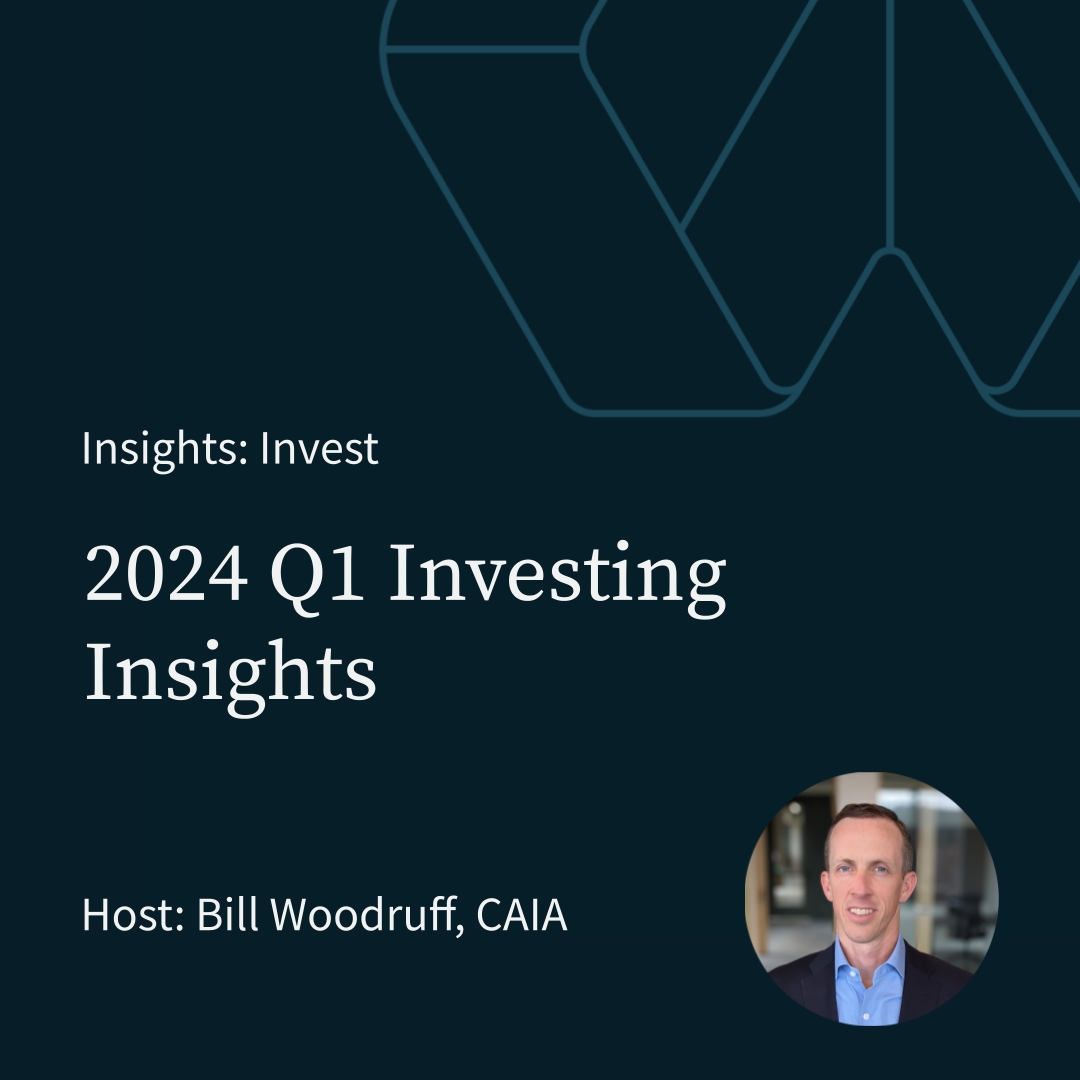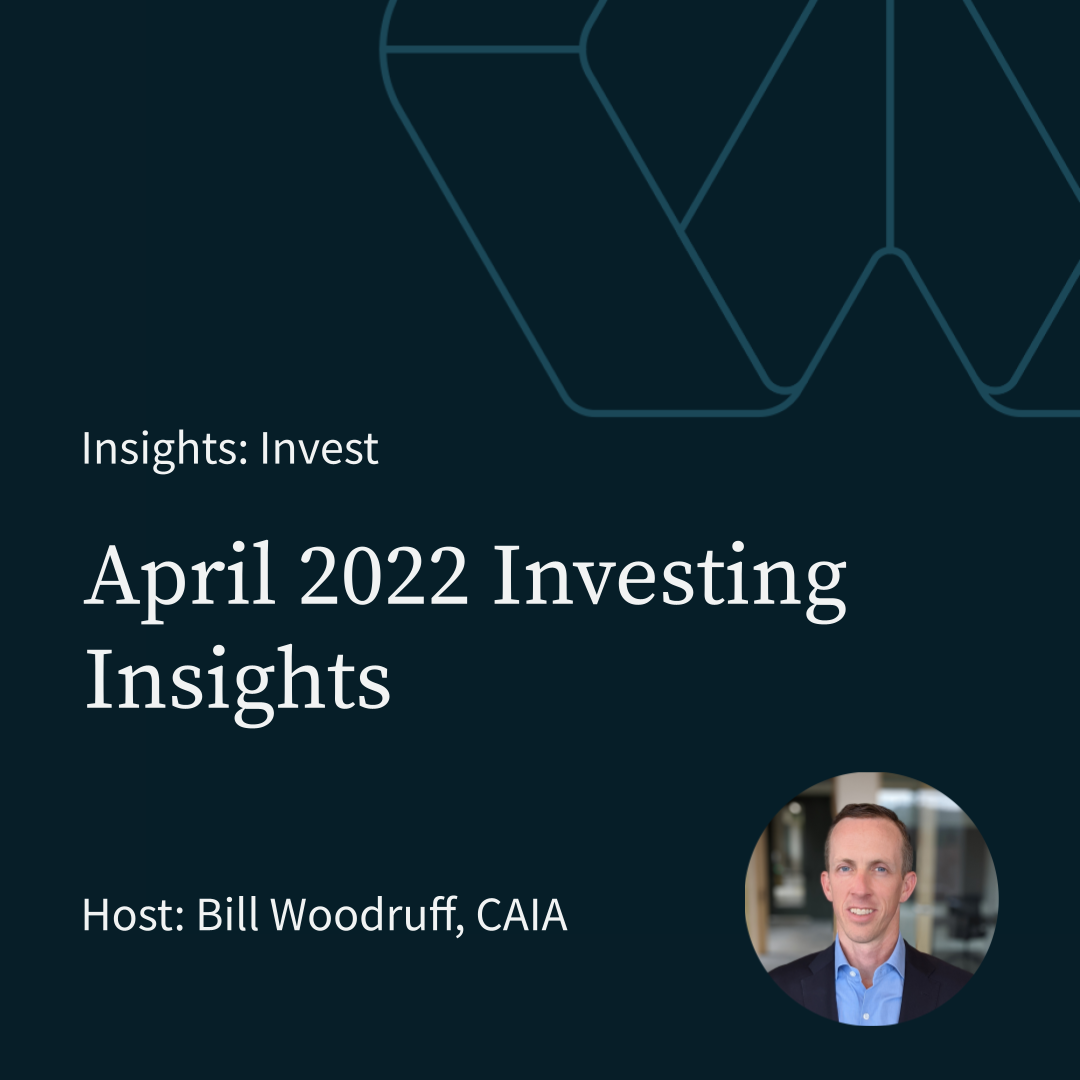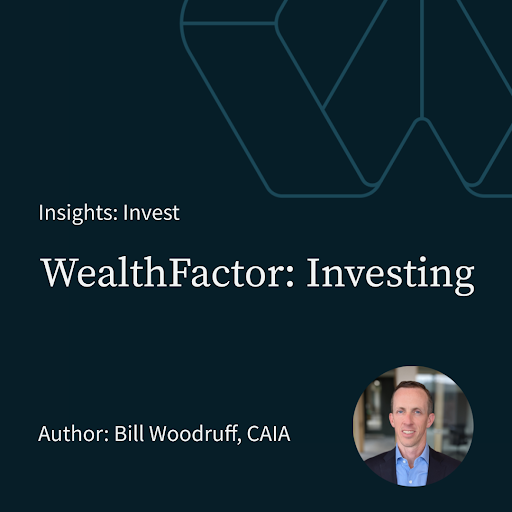Webinar: A Guide to RiskSmart Investing
Transcript:
Good afternoon and welcome everyone. I appreciate you taking the time to participate today. Today we'll be going through well factors risk spark investment philosophy. Before I get too far in a few words for compliance purposes, which I'll read this call is for informational purposes only and may be recorded statements made during this call are the opinions of a speaker and are subject to risk and uncertainty some of which are significant in scope. And by their very nature beyond the control of wealth factor. There can be no assurance that such statements will prove to be accurate, and actual results in future events could differ in a material way from said statements. Historical results are not necessarily indicative of future performance. So my name is Bill Woodruff. And for those of you who don't know me Don't know me as well. I've spent just over 20 years investing. I have a I graduated from the University of Portland with a degree in finance. I have a broad and diverse investment career experience set. That includes trading for a hedge fund, doing portfolio management in a variety of capacity capacities, manager, investment manager research and due diligence. I had the opportunity to start a mutual fund and was responsible for all investment activities for that mutual fund. That mutual fund business line was acquired by a public company called fortress Investment Group. I operated as a managing director for fortress after their acquisition of my mutual fund business line. I launched wealth factor after that, and the end of 2017. Well factor is a Lake Oswego based Investment Advisor. Our primary service is centered around our risk smart philosophy, where we provide custom plan oriented investment advice. We manage portfolios, which are primarily comprised of stocks and or bonds. And most of what we do is based on indices. Our client accounts are held in their names at independent third party custodians. And we charge point three 5% fees on assets that we manage up to $10 million, and then point 1% on assets over $10 million. At the end. Let me start out by painting a the broadest possible top level picture for what risk smart is risk smart has three different areas of focus. The first is what we call portfolio smart. This could also be thought of as the structure of the portfolio. And so there's a variety of philosophical elements here, the belief that investing, investors should avoid things like picking and timing. And so I think about that in multiple layers not just on an individual company basis, but also sector as well as geography, and then certainly the overall market or markets. The next ingredient from a portfolio smart perspective, is the avoidance of layers and and then complexity, there's some connectedness to those things. It's in my observations, layers lead to complexity. And in I believe that complexity almost never helps in accomplishing successful investment outcomes. The second component is fee smart. And it's my belief that there is a direct relationship between the amount of fees that are paid For investment advice or investment management, and the amount of risk that's taken, and it's my belief that high fees force risk taking. So at our founding point, our investment advice fee of 35 basis points, and then our primary use of index based investment strategies, keeps our fees very low and very efficient. The final of the three parts for risk Smart Investing is being taxed smart. Taxes are often an afterthought, or in some cases not even thought of at all. But I believe it's one of the areas where an investor can improve through activities and energy probably the easiest, out of all parts of investing. We have a variety of elements that go into enhancing the efficiency after tax for portfolios. I started well factor based on my observations of what I believe is an outdated industry.
05:02
organizations that have amassed incredible amounts of assets have been in business for a long time, and have been very slow to leverage technology for the benefits of their clients. And we're certainly seeing many organizations leverage technology for the benefits of their profit margins. But I continue to see I continue to I don't see much in the way of those efficiencies and opportunities of those efficiencies being passed on to clients. And so just as a generalization, here's what I what still exists in terms of layers of what the the mass advisors service offering looks like. So it's not uncommon that a brokerage firm a bank, or an RA
05:49
provides oversight or another set of services to an individual advisor that then outsources the investing to a fund or Or another investment manager. And then sometimes there's even a fourth layer in providing the serve service investment service to investor, which is called a turnkey asset management platform, which might take those three layers and add a technology element or tie them together. And so I look at, you know, thanks to technological innovation, as many of these layers as largely unnecessary today. And it's also my belief that they're not doing a whole lot other than increasing costs and fees, which again, it's my
06:33
belief that leads to risk this crappy as you increase fees for investing, you know, is there value and at what point does that perhaps change and so, you know, the bottom line is, is percent total fee, and I don't think about this just as the E associated with investment advice, but the true total cost including underlying mutual funds and ETFs however, you might get that investment exposure. And so I believe that there is absolutely benefits of receiving investment advice. Even if the quality of that advice isn't necessarily better than what you could do on your own. Having a disciplined and consistent steward to implement on your behalf and investment plan likely reduces the potential for emotion linked mistakes, which we're all human. And those those are very much real in investing. But I believe that very quickly, those benefits start to be outweighed by the negatives associated with high fees. The biggest part of that is forced increased risk taking. The first element I'll talk about is the fee smart element or fee efficiency. And so I believe the biggest mistake an investor can make is to pay somebody 1% to then pick funds and it probably even gets worse if they're both picking those funds. Timing those funds. So you end up with what is a very expensive structure. And so one that's going to cost a lot of money and fees over time, but two, which which will, which will likely degrade on performance. But two, and the concept that I've introduced is this idea of increased force risk taking. And so this is an example that illustrates why that exists. And so as of a few days ago, the 10 year Treasury yield. So if we're talking about fixed incomes, a little simpler fixed income yields a little bit simpler to conceptualize. So I'm going to use as an example, but it holds true across most investments in most asset classes. So if we look at that fixed income, arguably the safest area of fixed income is treasuries, April 20. The yield was point six 3% on the 10 year Treasury. Well, if you're if you're a service provider operates with a 1% fee and then invest in funds there. Total expense structure and this is generous likely, is 1.25%. And so the negative potential return. And there's a bit of oversimplified simplification here. And that price change for treasuries is a bit more complex and just the simple yield. But the net potential return over time for that investment is negative point, five 5%. And so this investment really doesn't make sense. Once you apply a significant amount of enlightened sets of layers of fees, and so the net impact here or the net effect, is largely that investment advice. person is forced to recommend things that have more risk than that baseline amount. This continues on that same theme, but visualizes it in what is an efficient frontier curve. So this is a rough visualization of that standard curve. And so right here at the end, so on the bottom, its risk and the top its return and so we're starting with And this is again just for visualization purposes starting with a portfolio of 100% treasuries, and we start to, in increments,
10:06
add stocks, and at some point, we have reduced the overall risk of the portfolio and increase return at the same time. And the driver behind that is the our assets that are correlated or providing diversification benefit. And then at some point, that curve goes the other way, and risk starts to go up and return probably also starts to go up to some degree as well do expand upon the last page. And that same concept, if you if you assume now a significant amount of fee, and you're forced to take on additional risk, and so I'm just oversimplifying this and say instead of right getting recommended a portfolio of 100% treasury bonds, I've now gotten recommended a portfolio of 100% corporate bonds. Those corporate bonds actually will be fairly uncorrelated to stocks in normal times, but many investors found out very quickly over the last couple of months that any bond that's riskier than treasuries ends up being far more correlated during periods where markets are declining rapidly. One, there's an entire shift in the risk spectrum by the elements of being forced into more risks. And then in addition to that, I also would suggest that the asset overall asset allocation device is probably also getting skewed up. So even in this curve, rather than being at this point, you might even be recommended or the advice you might be receiving might also have an increased amount of risky assets like stocks, increased risk leads to unnecessary downside. And that's a that's a key element to to talk about because it's my belief that when you have increased downside, it also increases the chance that emotional mistakes are made. The next element of risk smart is portfolio smart or being efficient and how we structure our portfolio. So I've touched on these a little bit. There's also some interconnectedness to the UI elements here. But the first one I'll talk about here is concentration. So, concentration is, in today's world, easy to avoid. indices make building and implementing a diverse portfolio. Simple. If you connect this to in the investment advice or investment management world, a concentrated portfolio, and I'll use a simple example, let's say you wanted to build a portfolio of 10 stocks. Well, the impact while that might have a enough technical diversity, the impact of each one of those positions now is very, very material to your performance, and it likely would require a significant amount of time and energy for an investment manager or investment advisor to do on each one of those 10 positions. And so because of that time and energy allocation likely would force that person to charge more. Whereas using an index as an investment universe, or really any repeatable universe of investments, or process avoids that where systems can be used and cost can can be kept low. The next element are layers and layers can be looked at in lots of different ways, but layers of management and oversight, those elements increase complexity and they increase expenses. And in my experience, I've rarely seen them add a material amount of value, especially in situations where the net end exposure ends up being a hyper diverse portfolio anyways, so in the you know, once the majority of the industry is building a very diverse portfolios for clients that end up with thousands of Have stocks in them when equities are used, and the same thing applies for bonds. And it once you get to a certain number of positions, that diversification, or the potential deviation of the results starts to from, let's say the s&p 500, or things that you can get exposure to cheap and easy by yourself starts to go way down. So what you end up with is a portfolio that grossa fees is likely to equal the market, but because of layers of costs and management, you're almost certainly going to underperform the overall market. And then the last is complexity. So that thematically there's some elements here that are that are similar to layers. But as well as the example I gave from the management of concentration, but to the extent your
14:51
strategy has complexities like the reliance of the timing of when you're invested or the selection of your securities, the Things will drive up costs. And the probability that the costs, the benefits associated with that will outweigh that increased cost to you, I think is is limited. It's also worth noting, and it's a nice segue into the next part that anything that's active and complex is likely less tax efficient as well. tax efficiency is, again, I think, often overlooked and certainly underappreciated. But I think it's one of the largest areas where a positive difference can be made. Technological innovation is a big reason for this. The example that I'll share here is let's say you have a fun that has an index that has 400 stocks in it well, if you own that you now have one tax decision, you either sell it or you don't sell it. technology today makes it possible for much smaller portfolio sizes to go out and buy those 400 positions. And there's a couple really important ingredients Here. One is commission costs buying 400 transacting 400 times is likely 400 different commissions, well commissions if they are approaching zero. In some cases they are zero. I would recommend strongly that investors have any material size, avoid execution, where conditions actually are zero. Because in the in the execution world, there's all sorts of ways for brokerage firms to make money around execution and execution can be far more valuable. The execution quality can be far more impactful than the difference between a cheap commission and a free commission. And the second element here is execution algorithms. To justify purchasing 400 positions, or transacting 400 times you have to have efficient execution. Well, thanks to technological innovation, the access to algorithms to enhance or optimize execution efficient See, is far more accessible back to the tax elements here. If you if you own one fun with those same 400 positions, you have one tax decision. If you own all 400 of those positions, now you have 400 unique tax decisions. And for a taxable investor, controlling when gains are realized, or actively harvesting losses, has a meaningful potential to add value after tax relative to just buying and holding a fun. It's also worth noting that a fund, even an index fund, you're subject to the transactions and the underlying tax impact associated with the management of that fund. In the case of mutual funds, not just the underlying management decisions, but also potentially to the other shareholders and their decisions to purchase or redeem may have tax impacts to your portfolio. So I hope you found it Today's overview guide to risk Smart Investing useful.
SUMMARY KEYWORDS
portfolio, investment, fees, risk, layers, investment advice, investing, element, investor, stocks, tax, treasuries, execution, smart, positions, assets, costs, increase, management, point










